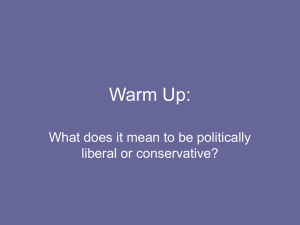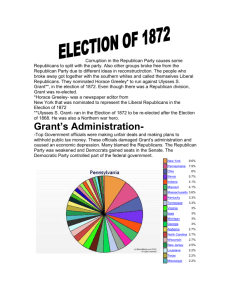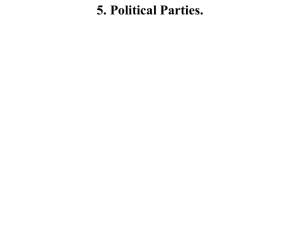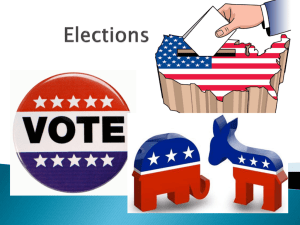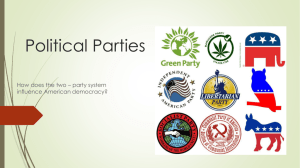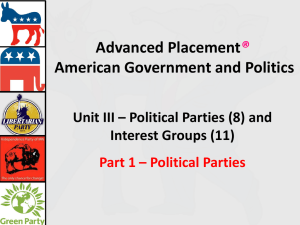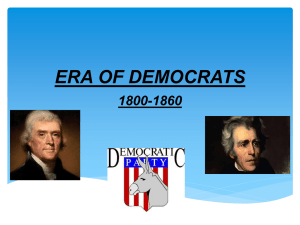DC Chapter 9 Summary
advertisement
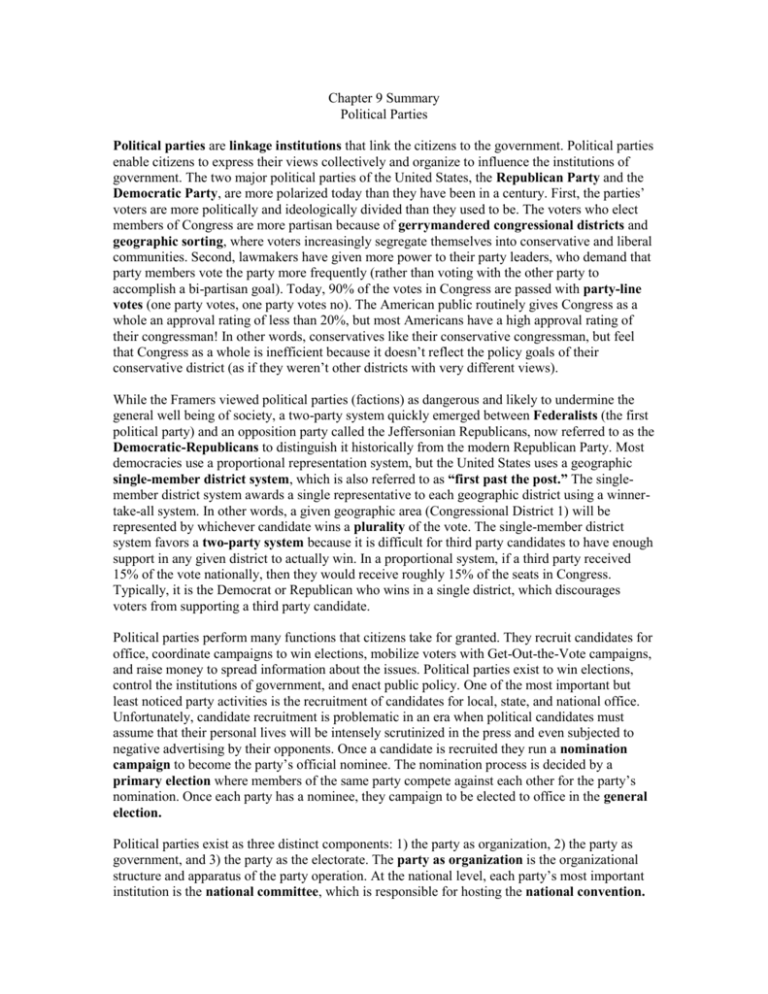
Chapter 9 Summary Political Parties Political parties are linkage institutions that link the citizens to the government. Political parties enable citizens to express their views collectively and organize to influence the institutions of government. The two major political parties of the United States, the Republican Party and the Democratic Party, are more polarized today than they have been in a century. First, the parties’ voters are more politically and ideologically divided than they used to be. The voters who elect members of Congress are more partisan because of gerrymandered congressional districts and geographic sorting, where voters increasingly segregate themselves into conservative and liberal communities. Second, lawmakers have given more power to their party leaders, who demand that party members vote the party more frequently (rather than voting with the other party to accomplish a bi-partisan goal). Today, 90% of the votes in Congress are passed with party-line votes (one party votes, one party votes no). The American public routinely gives Congress as a whole an approval rating of less than 20%, but most Americans have a high approval rating of their congressman! In other words, conservatives like their conservative congressman, but feel that Congress as a whole is inefficient because it doesn’t reflect the policy goals of their conservative district (as if they weren’t other districts with very different views). While the Framers viewed political parties (factions) as dangerous and likely to undermine the general well being of society, a two-party system quickly emerged between Federalists (the first political party) and an opposition party called the Jeffersonian Republicans, now referred to as the Democratic-Republicans to distinguish it historically from the modern Republican Party. Most democracies use a proportional representation system, but the United States uses a geographic single-member district system, which is also referred to as “first past the post.” The singlemember district system awards a single representative to each geographic district using a winnertake-all system. In other words, a given geographic area (Congressional District 1) will be represented by whichever candidate wins a plurality of the vote. The single-member district system favors a two-party system because it is difficult for third party candidates to have enough support in any given district to actually win. In a proportional system, if a third party received 15% of the vote nationally, then they would receive roughly 15% of the seats in Congress. Typically, it is the Democrat or Republican who wins in a single district, which discourages voters from supporting a third party candidate. Political parties perform many functions that citizens take for granted. They recruit candidates for office, coordinate campaigns to win elections, mobilize voters with Get-Out-the-Vote campaigns, and raise money to spread information about the issues. Political parties exist to win elections, control the institutions of government, and enact public policy. One of the most important but least noticed party activities is the recruitment of candidates for local, state, and national office. Unfortunately, candidate recruitment is problematic in an era when political candidates must assume that their personal lives will be intensely scrutinized in the press and even subjected to negative advertising by their opponents. Once a candidate is recruited they run a nomination campaign to become the party’s official nominee. The nomination process is decided by a primary election where members of the same party compete against each other for the party’s nomination. Once each party has a nominee, they campaign to be elected to office in the general election. Political parties exist as three distinct components: 1) the party as organization, 2) the party as government, and 3) the party as the electorate. The party as organization is the organizational structure and apparatus of the party operation. At the national level, each party’s most important institution is the national committee, which is responsible for hosting the national convention. The national convention nominates the party’s presidential and vice-presidential candidates and drafts the party platform, which states the party’s policy positions for that general election cycle. The national committee also raises campaign funds for party candidates, resolves disputes between party factions, and constructs a positive party image. The two major parties are decentralized and each state has its own party. So, in reality, there is no “national” Republican Party, but rather 50 separate state parties. The state parties are quite different based on their region, history, and demographics. At the local level, there exist civic groups that organize on behalf of the state party and its candidates. The party as government is the elected officials from each party. The majority party is the party that holds the majority of seats in either the House of Representatives or Senate. The majority party is “in power”, while the opposition is the minority party. The party as government plays a direct and formal role in the policymaking process. The party as the electorate is comprised of the individuals that vote for a particular party, identify with that party, or are registered members of that party. An individual’s party identification is often influenced by the party’s image, that is, what it is perceived to stand for or stand against. A negative party image may drive voters away so a positive party image is very important. About 1/3 of Americans are Republican, 1/3 are Democrat, and 1/3 are Independent. Obviously, Independents cannot vote “Independent” so they end up either a Democrat or a Republican when they vote. Party image can have an impact on whether a voter supports the Democrats or the Republicans. An individual with strong party identification may be a party activist, or part of the “base” of the party. Often, it is the party activists who vote in the primary election to determine the party’s candidate in the general election. Party identification trends exist based on race, gender, religion, class, ideology, region, and age. The United States has always had a two-party system, but the two major parties during a given party era have changed over time. The first party era was 1796-1824 and the two major parties were the Federalists and Democratic-Republicans (Jeffersonian Republicans). The election of Thomas Jefferson in1800 brought the Democratic-Republicans to power and they remained the dominant party. The second party era was 1828-1860. A faction within the DemocraticRepublicans that was led by Andrew Jackson became the Democratic Party, which was opposed by the Whig Party. The future of slavery led to fractions within both parties and the founding of anti-slavery party called the Republican Party. Abraham Lincoln’s election in 1860 marks the beginning of the third party era, 1860-1892, dominated by the Republican Party. The Democratic Party remained influential in the southern states after the Civil War. Industrialization had changed the policy debates on social and economic issues by the 1890s and the rise of populism influenced the Democratic Party. The election of 1896 was a Republican victory, but marks the beginning of a fourth party era, 1896-1928, wherein the Republican Party became the party of “big business” and continued free markets. In 1932, after three years of the Great Depression, the Democrats won a significant victory led by Franklin Roosevelt. The Democratic Party’s New Deal coalition would dominate the fifth party era, which lasted from 1932-1964. The New Deal coalition fragmented in the 1960s over the civil rights movement and Vietnam War. In each of these party eras, one of the major parties was dominant and often controlled both chambers of Congress and the White House at the same time, what is called unified government. The beginning of each party era was marked by a critical election (1800, 1828, 1860, 1896, 1932) that resulted in an electoral realignment, the replacement of one dominant party with another. Understand that for most of American history, one party has enjoyed unified government and was dominant within the policymaking process. By definition, divided government exists when one party controls at least one chamber of Congress and another party controls the White House. In 1968, our most recent critical election, the Republicans took back the White House and the Democrats retained control of Congress. The norm since 1968 has been divided government because the American people have not experienced a long-term realignment that fully empowered either major party with unified government. We are now so used to divided government and so polarized ideologically that many people are fearful of the prospect of unified government. The elections of 1980 (Ronald Reagan) and 2008 (Barack Obama) were significant, but did not result in a long-term realignment or unified government. A distinguishing feature of the contemporary party era is party polarization, that is, the division between the two parties on most policy issues. Most of the 435 congressional districts are “safe” districts where one party has a large majority. Incumbents in a safe district will almost automatically be re-elected in the general election so any electoral challenge will likely come from within their own party during the primary election. In order to win their party’s nomination, the incumbent may be moved further to the ideological extreme of their party in order to win the support of the party’s “base” during the primary election. Over time, the result of this process is the disappearance of moderates. Republicans in safe districts become very conservative Republicans, while Democrats in safe districts become very liberal Democrats. One reason for this trend is that congressional redistricting (gerrymandering) has eliminated most competitive (swing) districts. In 2012, only 23 out of 435 House seats were considered competitive, that is, capable of being won by either the Republican candidate or Democratic candidate. Another reason for this trend is “self-sorting” where liberals and conservatives choose to segregate themselves by living in “conservative” and “liberal” areas surrounded by other like-minded people. The problem is not that congressional districts produce very conservative Republicans or very liberal Democrats, but rather that the voters in those districts demand that their congressman not compromise with the other side. If a congressman does try to compromise they may be challenged in the primary election and the party activists may replace them with someone more “loyal” or “pure.” Although the United States has always had a two-party system, the country has always had influential third parties. Influential third parties have included the Populist, Progressive, Socialist, Libertarian, Reform, and Green parties. Because third parties almost always lost at the national and state level, such parties exist as a protest movement against the two major parties. Third parties are often sources of new policy ideas and realignment. Sometimes third parties play a significant role in elections by splitting a major party’s vote. The most important role that third parties play is changing the platforms of the major parties. If enough voters are attracted to a third party then one of the major parties will adopt the policy positions of the third party in order to win voters. The fact that America’s electoral system makes it difficult for third parties to do well has resulted in third party “energy” being directed within the two-party system. For example, the Tea Party is not an actual third party because it doesn’t run separate candidates who compete against Republicans. The Tea Party is a caucus within the Republican Party that has significantly changed the Republican Party’s platform since 2010. Likewise, Occupy Wall Street did not run any candidates, but was extremely successful in changing the policy priorities and rhetoric of the Democratic Party. Not wanting to split the Democratic vote, the Independent (Democratic Socialist) Bernie Sanders is running for the Democratic nomination with the intention of changing the Democratic Party from the inside rather than challenging it from the outside like Ralph Nader and the Green Party did in 2000.

